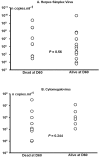Cytomegalovirus and herpes simplex virus effect on the prognosis of mechanically ventilated patients suspected to have ventilator-associated pneumonia
- PMID: 23236477
- PMCID: PMC3517464
- DOI: 10.1371/journal.pone.0051340
Cytomegalovirus and herpes simplex virus effect on the prognosis of mechanically ventilated patients suspected to have ventilator-associated pneumonia
Retraction in
-
Retraction: Cytomegalovirus and Herpes Simplex Virus Effect on the Prognosis of Mechanically Ventilated Patients Suspected to Have Ventilator-Associated Pneumonia.PLoS One. 2024 Oct 14;19(10):e0312324. doi: 10.1371/journal.pone.0312324. eCollection 2024. PLoS One. 2024. PMID: 39401238 Free PMC article. No abstract available.
Expression of concern in
-
Expression of Concern: Cytomegalovirus and Herpes Simplex Virus Effect on the Prognosis of Mechanically Ventilated Patients Suspected to Have Ventilator-Associated Pneumonia.PLoS One. 2022 Dec 13;17(12):e0278002. doi: 10.1371/journal.pone.0278002. eCollection 2022. PLoS One. 2022. PMID: 36512559 Free PMC article. No abstract available.
Abstract
Objective: Cytomegalovirus (CMV) and herpes simplex virus (HSV) are common viruses that can affect critically ill patients who are not immunocompromised. The aim of this study was to determine whether the identification of CMV and/or HSV in mechanically ventilated critically ill patients suspected of having pneumonia was associated with an increased mortality.
Design: Prospective epidemiological study.
Setting: Medical intensive care unit of a tertiary medical center.
Patients: Ninety-three patients with suspected pneumonia.
Interventions: Patients with suspected pneumonia had bronchoalveolar lavage and blood samples taken to confirm the diagnosis. Antigenemia was used to detect CMV in the blood. Bronchoalveolar lavage samples were submitted to testing using quantitative real-time Polymerase Chain Reaction.
Measurements and main results: We identified 22 patients with a CMV infection, 26 patients with an HSV infection and 45 patients without CMV or HSV infection (control group). Mortality at day 60 was higher in patients with a CMV infection than in patients from the control group (55% vs. 20%, P<0.01). Mortality at day 60 was not significantly increased in the group with HSV infection. Duration of ICU stay and ICU mortality were significantly higher in patients with CMV infections when compared to patients from the control group, whereas ventilator free days were significantly lower in patients with CMV infections when compared to patients from the control group.
Conclusions: In critically ill patients, a CMV infection is associated with an increased mortality. Further interventional studies are needed to evaluate whether treatment could improve the prognosis.
Conflict of interest statement
Figures



References
-
- Cook CH, Martin LC, Yenchar JK, Lahm MC, McGuinness B, et al. (2003) Occult herpes family viral infections are endemic in critically ill surgical patients. Crit Care Med 31: 1923–1929. - PubMed
-
- Heininger A, Hamprecht K (2006) How cytomegalorvirus reactivation could cause pulmonary pathology in septic hosts. Crit Care Med 34: 929–930. - PubMed
-
- Heininger A, Jahn G, Engel C, Notheisen T, Unertl K, et al. (2001) Human cytomegalovirus infections in nonimmunosuppressed critically ill patients. Crit Care Med 29: 541–547. - PubMed
-
- Heininger A, Vogel U, Aepinus C, Hamprecht K (2000) Disseminated fatal human cytomegalovirus disease after severe trauma. Crit Care Med 28: 563–566. - PubMed
Publication types
MeSH terms
Substances
LinkOut - more resources
Full Text Sources

